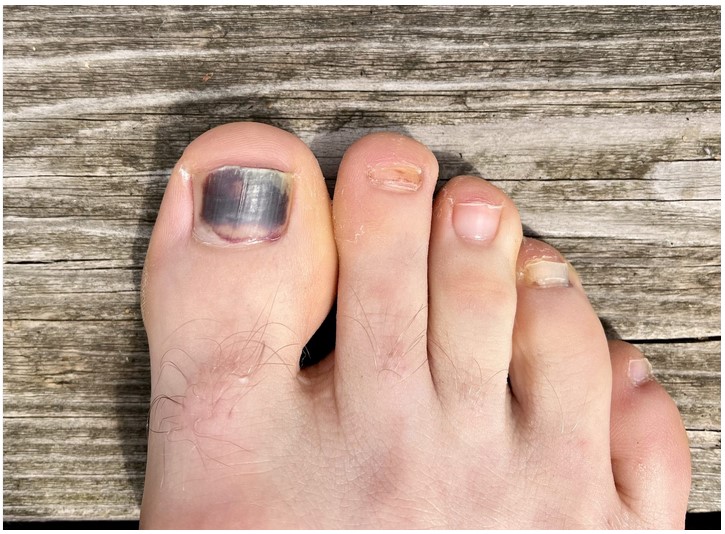
Black spots on toenails can be a cause for concern for many people. They can be caused by a variety of factors, including fungal infections, trauma, and even certain medical conditions. It is important to identify the cause of the black spots in order to determine the best course of treatment. This article will discuss the various causes of black spots on toenails, as well as the treatments available for managing them. Additionally, it will provide tips for preventing black spots from occurring in the future.
What Causes Black Spots on Toenails and How Can They Be Treated?
Black spots on toenails are a common condition known as melanonychia. This condition is caused by an increase in the amount of melanin, the pigment that gives skin and hair its color, in the nail. It can be caused by a variety of factors, including genetics, trauma, fungal infections, and certain medications.
The most common cause of melanonychia is trauma to the nail. This can be caused by wearing tight shoes, dropping something heavy on the toe, or stubbing the toe. In some cases, the trauma may be so minor that the person does not even remember it.
Fungal infections are another common cause of black spots on toenails. Fungal infections can be caused by wearing damp socks or shoes, walking barefoot in public places, or having a weakened immune system.
Certain medications can also cause melanonychia. These include chemotherapy drugs, antimalarial drugs, and some antibiotics.
In most cases, black spots on toenails are harmless and do not require treatment. However, if the spots are accompanied by pain, redness, or swelling, it is important to see a doctor. A doctor can diagnose the cause of the spots and recommend the appropriate treatment.
Treatment for melanonychia depends on the underlying cause. If the spots are caused by trauma, they may resolve on their own. If the spots are caused by a fungal infection, antifungal medications may be prescribed. If the spots are caused by a medication, the doctor may recommend switching to a different medication.
In some cases, the doctor may recommend a procedure called a nail avulsion. This involves removing the affected nail and allowing a new nail to grow in its place.
In conclusion, black spots on toenails are a common condition known as melanonychia. The cause of the spots can vary, but the most common causes are trauma, fungal infections, and certain medications. In most cases, the spots are harmless and do not require treatment. However, if the spots are accompanied by pain, redness, or swelling, it is important to see a doctor for diagnosis and treatment.
Understanding the Different Types of Black Spots on Toenails and How to Manage Them
Black spots on toenails can be a cause for concern, as they can be indicative of a number of different conditions. It is important to understand the different types of black spots on toenails and how to manage them.
The most common type of black spot on toenails is a subungual hematoma, which is caused by trauma to the nail. This type of black spot is usually caused by a direct blow to the nail, such as stubbing a toe or dropping something heavy on the toe. The spot will usually be dark purple or black in color and may be painful. Treatment for a subungual hematoma is typically conservative, and involves soaking the toe in warm water and gently massaging the area to help disperse the blood. If the spot does not improve, a doctor may need to drain the area.
Another type of black spot on toenails is a melanonychia, which is caused by an increase in melanin production in the nail. This type of black spot is usually caused by a fungal infection, such as tinea unguium, or by a condition known as melanoma. Melanonychia can also be caused by certain medications or by exposure to certain chemicals. Treatment for melanonychia depends on the underlying cause, and may involve antifungal medications or surgery.
Finally, black spots on toenails can also be caused by a condition known as onychomycosis, which is a fungal infection of the nail. This type of black spot is usually caused by a fungus that lives in warm, moist environments, such as showers or swimming pools. Treatment for onychomycosis typically involves antifungal medications, which can be taken orally or applied directly to the nail.
In conclusion, black spots on toenails can be indicative of a number of different conditions. It is important to understand the different types of black spots on toenails and how to manage them. If the black spot does not improve with conservative treatment, it is important to seek medical advice to determine the underlying cause and appropriate treatment.
Conclusion
In conclusion, black spots on toenails can be caused by a variety of factors, including trauma, fungal infections, and melanoma. It is important to identify the cause of the black spots in order to properly manage them. If the cause is trauma, the spots may resolve on their own. If the cause is a fungal infection, antifungal medications may be necessary. If the cause is melanoma, early detection and treatment is essential. It is important to seek medical advice if black spots on toenails persist or worsen.